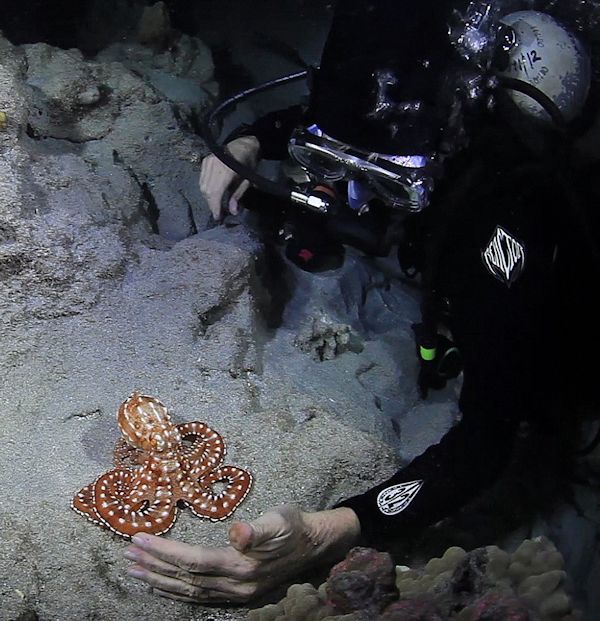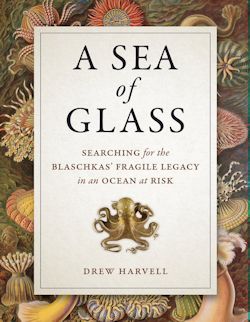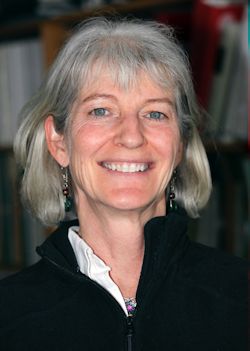SEJournal Online is the digital news magazine of the Society of Environmental Journalists. Learn more about SEJournal Online, including submission, subscription and advertising information.
 |
| Author and evolutionary biologist Drew Harvell during an ocean dive to find living counterparts to glass models in Cornell’s Blaschka collection. Photo courtesy Harvell. |
Between the Lines: Scientist Finds Nature’s Art Beneath the Seas
One of the more unique entries in SEJ’s 2017 Rachel Carson Environment Book Award competition was Cornell University evolutionary biologist Drew Harvell’s “A Sea of Glass,” a book that marries ocean science with art. Winner of an honorable mention, Harvell searched the world for living counterparts crafted more than 150 years ago by father-and-son glass artisans Leopold and Rudolf Blaschka.
One judge said the beautifully written and illustrated book becomes so engaging it is “a love story in the first-person narrative not usually found in academic journals.” Another said the volume “is just the sort of novel blend of art and science needed to draw broad audiences to the story of our oceans and the imperative to save them.”
SEJournal BookShelf editor Tom Henry spoke with Harvell about how she conceived and executed the book, while the author was travelling in Europe to give a talk and show a 2015 ocean documentary about her work, Fragile Legacy, at the historic Musee Oceanographique in Monaco.
 |
SEJournal: What gave you the inspiration to write “A Sea of Glass”? How did you know in your heart there was a good story to tell?
Drew Harvell: It was one of those projects that captivated me and would not let me go until I had done it. I have the New York Times to thank for publishing some earlier short pieces I did (see “Glass Mirrors Life in the Seas” and others) that gave me confidence to develop the project further. These earlier pieces were writing from the heart about my research/adventure experiences and very much the same approach I used in “A Sea of Glass” to tell the story of our quest in underwater dives to search the oceans for living matches to The Blaschka Collection.
SEJournal: This is such a unique book in how it blends art, science and natural history. What challenges did you encounter in not only doing your research, but also in presenting it with balance and with the kind of writing clarity it takes?
Harvell: My largest challenge as a scientist was to write well, in a way that would be engaging to a broader audience. I had a lot of help from Merrik Bush, my editor at University of California Press. They were a wonderful publisher that was willing to nurture and support a first-time tradebook writer.
SEJournal: Few people know of the father-son glassmaking team of Leopold and Rudolf Blaschka. What caught your eye about their artwork from more than 150 years ago?
Harvell: As a young faculty member (um, 30 years ago!), I was given the responsibility to curate and care for Cornell’s Blaschka collection. The minute I opened the first box and saw the precision and mastery of the glass, I was hooked and had to keep looking through each, even more exciting box. I have worked with glass restoration experts over all this time to restore and bring to exhibition Cornell’s Blaschka collection, the largest in the world at over 570 models. Last year, Corning Museum of Glass did a big exhibit of our models and then Cornell’s Johnson Museum had a fabulous exhibition this year. In each case, it’s been so exciting that we can also introduce an appreciation for marine biodiversity and natural history and ocean conservation theme.
I am learning that people with less familiarity
with [invertebrate marine animals] are helped
by seeing them first as masterpieces of art.
It helps translate them to a human scale.
SEJournal: How did another medium — art — inspire you to learn more about science and the environment? Would you recommend other writers go beyond their comfort zones for inspiration?
Harvell: I am learning a lot and am very inspired about the power of art to inspire interest in natural history. My greatest passion is the vision of invertebrate marine animals, like starfish and jellyfish and sea anemones and octopus. But I am learning that people with less familiarity with these spineless wonders are helped by seeing them first as masterpieces of art. It helps translate them to a human scale.
SEJournal: What reactions did you get when you first proposed this book? Were you surprised by them?
 |
| “A Sea of Glass” author Drew Harvell |
Harvell: I was so lucky and surprised at how immediately my editor at University of California Press embraced the project. At the time, that editor was Blake Edgar, and he loved the idea immediately and helped me develop it in a way that supported perfectly my vision for it.
SEJournal: What challenges have you had in marketing it?
Harvell: This seems to be the greatest challenge — getting the word out! It has won two very nice awards, the National Outdoor Book Award (in 2016, winner of the Natural History Literature category) and an honorable mention in SEJ’s Rachel Carson Environment Book Award. It was a top pick of Smithsonian as an Art-Science book. I always sell a lot of books at my talks, and many people buy multiple copies as gifts and then come back for more. But otherwise, it seems hard to actually sell books. I would be grateful for any advice from you or your readers on this. I care a lot about the message and wish the book would reach a wider audience.
SEJournal: What's next in store for you? Another passionate search, quest or exploration?
Harvell: We continue our search for the different Blaschka animals. I am excited to partner with some of the institutions in the Mediterranean. I am especially excited to follow up on some old Blaschka correspondence with the Stazione Zoologica in Naples. I was so excited by finding the old Blaschka correspondence in their archives with species list (from 1877) that I wrote this in a blog post about it: “Inside the archives, I examine Leopold Blaschka’s letter, in exacting cursive, of 4 February 1877. He specifies a list of 41 preserved marine animals to be sent to help him construct in glass scientifically accurate replicas of marine invertebrates.”
* From the weekly news magazine SEJournal Online, Vol. 3, No. 20. Content from each new issue of SEJournal Online is available to the public via the SEJournal Online main page. Subscribe to the e-newsletter here. And see past issues of the SEJournal archived here.












 Advertisement
Advertisement 



